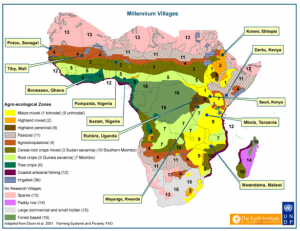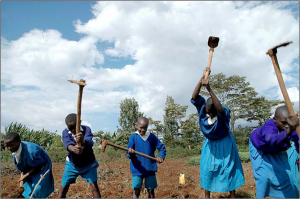The Millennium Villages project offers a bold, innovative model for helping rural African communities lift themselves out of extreme poverty. To date, the Millennium Villages project has reached nearly 400,000 people in 79 villages. The villages are in 10 African countries (Ethiopia, Ghana, Kenya, Malawi, Mali, Nigeria, Rwanda, Senegal, Tanzania, and Uganda), and are located in different agricultural zones that reflect the variety of farming, water, and disease challenges facing the continent.
African countries (Ethiopia, Ghana, Kenya, Malawi, Mali, Nigeria, Rwanda, Senegal, Tanzania, and Uganda), and are located in different agricultural zones that reflect the variety of farming, water, and disease challenges facing the continent.
It is not so much an innovation as it is an integral development strategy. Indeed, what makes the MVP project remarkable and unique is its integrative approach to development: it looks to increase food security, education, health services and amelioration of infrastructure all at once in a 5 year period. The villages are carefully selected to make sure that the project covers different agricultural sectors so that the agricultural development strategy becomes more credible and applicable across all of Africa. The hope is to adopt the strategy in an entire district and eventually the country, if the villages were to be successful.
Gathering a budget large enough to precede with the project, the millennium villages initiative has proven to be successful in many short term goals, such as an increase of crop production, improvement of health and education services and some evidence of self lead businesses. The standard of living of all of its participants has substantially increased because of it, in ways that would be impossible without the program. The MVPs are doing good, but is it really good enough?
It is an ambitious project. It seems to have too many goals and too little time. But will the people have time to adapt? Will it be sustained through the generations? Criticisms to the MVP’s have been many, regarding its sustainability, scaling up and scientific legitimacy. The two strongest critiques to the project point out to the problems that the project encounters when thinking about sustainability and scaling it up. Let’s start with sustainability and I will address scaling up in a future post.
The sustainability of these projects is widely questioned. Once the 10-year program ends, will the progress that the community faced be sustained and increased? This question cannot have a straight answer. The sustainability will be judged on how the community can maintain and promote the services that the aid and donations once provided.
Since it is an approach that focuses on agricultural improvement, it is of paramount importance to look at the sources of the agricultural donations and its usages. Where do the fertilizers and seeds come from, is there enough infrastructure to assure irrigation and is there a market to assure a revenue for the farmers? Too often, an improved seed means that they are genetically modified and therefore it is sterile. Future seeds will not be useful for the farmers; therefore they’ll need to keep buying the seeds to assure production, which may lead to further debts. By offering unfertile seeds as part of the development strategy, the help offered for one generation of these villagers will not help the next one. It would actually make them dependent on donations or companies that hold that have access to seeds. This needs to be avoided at all cost within the project even if it means increasing the aid or cost of initial investment.
Similarly, dependence on fertilizer will eventually saturate the soil and new fertilizers and pesticides will be needed. This may create a vicious cycle of debt and dependency that many farmers in India, once helped by the “green revolution” now face. Of course, this is unless they, once again, receive constant help from the government. Therefore, sustainability of the project needs to be evaluated on the production side, but also on the creation-of-autonomy side. There needs to be a more integrative approach to what the soil and the environment offer. If the village is settled in an unfertile, dry and unproductive soil the project may in any case be completely useless in the long run. Helping these villagers for one generation will not help the next one. So it seems that the sustainability of the project is not as evident as the proponents suggest.
On a final note, it is important to remember that this is a project where development is focused on agriculture. The hope is to increase the revenue of the villagers by increasing agricultural output. If the program scales up and is successful (as the planners envision), it would entail that many African countries will end up tied to a fate of an agriculture-dependent economy. Although this is not necessarily bad, the international economic climate has not and probably will not greatly benefit agriculture-dependent countries. Moreover, if all African countries begin to be important producers of agricultural products at the same time, this will lower the prices and lower the revenues of all the countries.
increasing agricultural output. If the program scales up and is successful (as the planners envision), it would entail that many African countries will end up tied to a fate of an agriculture-dependent economy. Although this is not necessarily bad, the international economic climate has not and probably will not greatly benefit agriculture-dependent countries. Moreover, if all African countries begin to be important producers of agricultural products at the same time, this will lower the prices and lower the revenues of all the countries.


